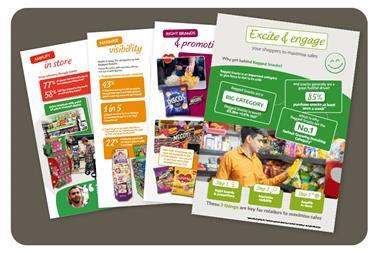The past five years have seen seismic shifts in retail, with strong and unprecedented multiple growth, high-end consolidation and changes of ownership, topped off by the deepest recession in living memory. So predicting the next five years is an ambitious task, but we at C-Store are confident that certain key issues on the convenience agenda today will remain so in the short- and medium-term.
Current thinking is that the small store industry has generally weathered the recession well. And growing social and economic concerns, combined with an ageing population (nearly a quarter of Brits will be over 60 by 2016 according to ONS estimates) will mean that by 2015, consumers will be shopping more frequently, more locally, and more last minute, all of which is good news for neighbourhood convenience stores. In fact, IGD predicts that sales through the sector could reach a whopping £41.4bn by the end of 2014 up 36.6% from now.
And while shoppers will be getting older, retailers are set to get younger. "A significant investment in skills and training will change the way a career in retail is perceived," says Professor Joshua Bamfield, director of the Centre for Retail Research. "By 2015 I would expect the market to be brimming with a much younger, highly trained, more dynamic generation of retailers." In short, retail in 2015 will be sexy.
However, the allure of convenience won't be lost on the multiples. Tesco, Sainsbury's and most recently Waitrose all plan to grow their convenience estates over the next five years. Consequently, convenience stores of the future will have to play much harder to their associated strengths and offer a wider range of products and services than ever before. "The c-store of the future will have a comprehensive range of products consistently available," predicts Craig Farrington, head of development for Costcutter. "Providing everything for a complete meal solution will be very important in helping to maintain customer loyalty. To meet this demand retailers will need to enhance their food-to-go offer, increase space allocated to chilled alcohol, and look carefully at meal accompaniments."
And more products and services obviously means more space. The average size of convenience stores has been steadily increasing over the past decade, and this trend is expected to continue into 2015.
However, with land at a price premium and planning regulations set to get tougher, it is unlikely that many of these super-convenience stores will be new-builds, so retailers who wish to expand stores or open large new ones will have to get a lot more savvy with their buying and building practices.
And speaking of savvy buying, shoppers in 2015 are also expected to place a greater focus on value for money than they do now, says Gavin Rothwell, IGD senior business analyst. "Delivering better value for money will have become embedded in the sector; price positioning will have been sharpened and promotions communicated more effectively."
Over the next eight pages, we take a look at some of the key trends that will affect the way our sector operates. Here's to the future.
Current thinking is that the small store industry has generally weathered the recession well. And growing social and economic concerns, combined with an ageing population (nearly a quarter of Brits will be over 60 by 2016 according to ONS estimates) will mean that by 2015, consumers will be shopping more frequently, more locally, and more last minute, all of which is good news for neighbourhood convenience stores. In fact, IGD predicts that sales through the sector could reach a whopping £41.4bn by the end of 2014 up 36.6% from now.
And while shoppers will be getting older, retailers are set to get younger. "A significant investment in skills and training will change the way a career in retail is perceived," says Professor Joshua Bamfield, director of the Centre for Retail Research. "By 2015 I would expect the market to be brimming with a much younger, highly trained, more dynamic generation of retailers." In short, retail in 2015 will be sexy.
However, the allure of convenience won't be lost on the multiples. Tesco, Sainsbury's and most recently Waitrose all plan to grow their convenience estates over the next five years. Consequently, convenience stores of the future will have to play much harder to their associated strengths and offer a wider range of products and services than ever before. "The c-store of the future will have a comprehensive range of products consistently available," predicts Craig Farrington, head of development for Costcutter. "Providing everything for a complete meal solution will be very important in helping to maintain customer loyalty. To meet this demand retailers will need to enhance their food-to-go offer, increase space allocated to chilled alcohol, and look carefully at meal accompaniments."
And more products and services obviously means more space. The average size of convenience stores has been steadily increasing over the past decade, and this trend is expected to continue into 2015.
However, with land at a price premium and planning regulations set to get tougher, it is unlikely that many of these super-convenience stores will be new-builds, so retailers who wish to expand stores or open large new ones will have to get a lot more savvy with their buying and building practices.
And speaking of savvy buying, shoppers in 2015 are also expected to place a greater focus on value for money than they do now, says Gavin Rothwell, IGD senior business analyst. "Delivering better value for money will have become embedded in the sector; price positioning will have been sharpened and promotions communicated more effectively."
Over the next eight pages, we take a look at some of the key trends that will affect the way our sector operates. Here's to the future.





























No comments yet